(Written by William)
I have built a couple of LEGO Technic sets in recent months and I really liked the building experience. I normally work with standard LEGO System sets, so the design and construction of LEGO Technic felt fresh and foreign. I’m very particular in what LEGO sets I give a chance to. Because the look of the model is highly important to me, I tend to gravitate toward LEGO System sets. But with the recent influx of expensive LEGO sets that include both good looks and interesting LEGO Technic functions, I realized there is a lot of building potential I know little to nothing about. So, when I had an opportunity to pick out a set to review, I decided to give the #42111 LEGO Technic Fast & Furious Dom’s Dodge Charger a look.
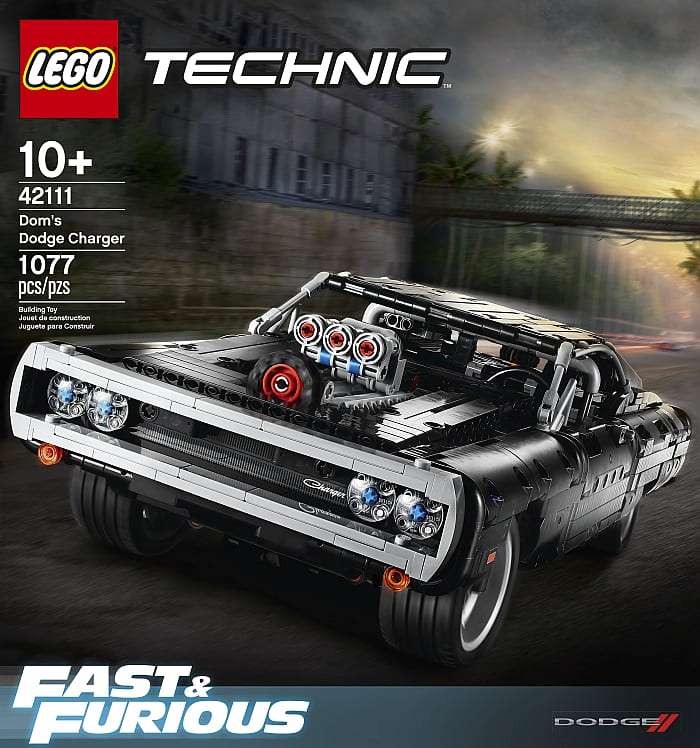
Normally, I avoid cars from LEGO Technic as I feel they are often overdone. But this particular set not only has a specific car company in mind, but it is also tied to a film. As demonstrated by this model, LEGO puts their best foot forward when a set features an intellectual property.
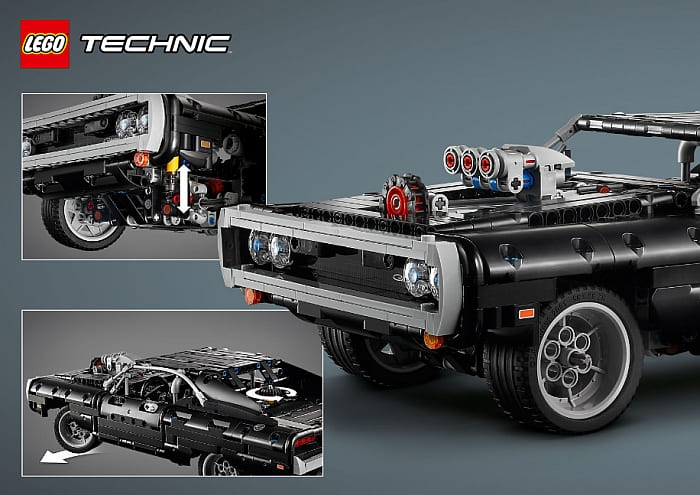
To be honest, this set has mechanical parts I’m still not entirely sure what they are used for. I have some guesses, which I talk about in the video below, so check that out and feel free to comment. Then, we will discuss some of the interesting building techniques I found in the set.
If you are an old hand at LEGO Technic building, none of what I say will be new to you. But as I’m fairly new to LEGO Technic, I still get excited when a set can take me out of my comfort zone, and the Dodge Charger has certainly done that. It really opened my eyes to what LEGO Technic has to offer. So, let’s take a look.
LEGO TECHNIC & ROTATIONAL MOVEMENT
Every time I build a LEGO Technic set, it feels as though I’m learning fundamental building principles all over again. This is because, by its very nature, LEGO Technic is a different building structure than LEGO System. Despite having numerous parts that both systems can use, the fundamental purpose differs in what they offer.
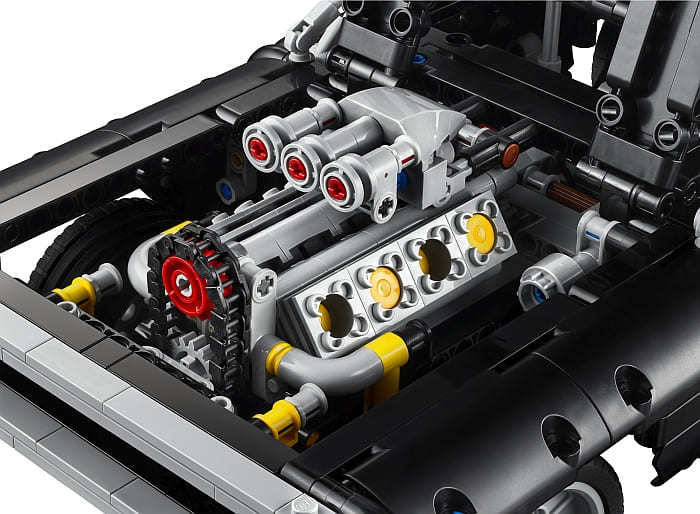
Put it simply, LEGO System is focused on recreating the shape and form of an object. Capturing the detail of what something is, is where LEGO System excels. LEGO Technic, on the other hand, concerns itself with an object’s functionality. In essence, LEGO Technic strives to recreate what something can do. And this is what brings us to rotational movement.
Mechanically, you’d be hard-pressed to find things that don’t have some sort of rotational movement in their construction. Wheels and hinges play such a big element in how things move. Many times, a device’s cleverness comes from how it can restrict or modify rotational movement and turn it into something that doesn’t look anything like a circular action. As an example, we’ll look at three features found in the Dodge Charger. The steering system, the eight-cylinder engine, and the lever that makes the car jump – each of them transform their basic turns into something dramatic.

The steering is probably the simplest. There is an exposed gear behind the back window. This is what you can use to steer the vehicle. Apart from a few gear exchanges through the length of the car, the movement stays as a circular pattern. Then you get to the front of the car where a gear comes into contact with a piece that has a built-in gear rack. A gear rack is simply a straight piece that has gear teeth, but no curve to it. The gear rack changes the rotational movement to something more linear. The rack goes in the direction that the round gear pushes it in. However, this rack is locked into place with several links that are attached to the front wheels. This both restricts how far the rack can move as well as tilts the tires in a specific direction, thus giving us steering!

Next up is the engine. It is powered by the back tires. As the tires move, they turn a shaft that also runs the length of the vehicle. At the end of this shaft system are four cranks. Each crank has an arm with a ball at the end. This ball is covered with a wheel hub that is then inserted into a housing. The ball sections handle all the awkward tilting of the pieces, but since this is covered by the wheel hubs, all you see are the pistons moving in the engine. Additionally, by placing them in a certain position, they also alternate, creating a mesmerizing action.
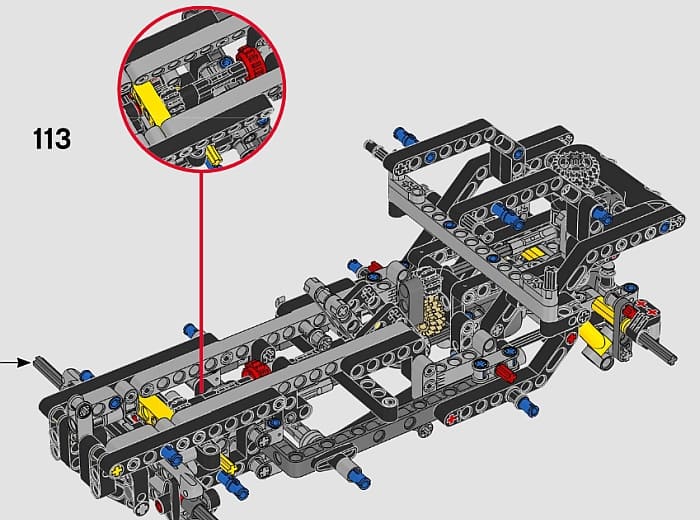
Finally, we move onto the gear shift, which operates the lift system that allows the car to jump. Unlike the other features, this one does not immediately look like rotational movement. It’s a lever after all. However, the lever’s toggling movement is simply a very limited section of rotational movement. In other words, an arc or angle of a circle, kind of like a slice of pie or pizza. This is made a little clearer when you attach the thin lift-arms that have a rounded section to them. This is part of the rotational movement that is being used. Tilting back on the lever enacts a series of hinges that twist and turn to find the path of least resistance. This ultimately pushes down a frame that forces the front of the car up, thus recreating a jump.
CREATING FLEXIBILITY WITH LEGO TECHNIC
Considering the fact that LEGO Technic is a building system that moves, it will naturally require some flexibility in its designs. Absorbing movement is a crucial component since something that is too rigid will only break when pushed. This is best seen in the rear wheels of the vehicle. The car has shocks, so will be in random positions from time to time. However, the back wheels are what powers the pistons, so you need a way to have your entire gear system flex in some way to handle the odd positioning.
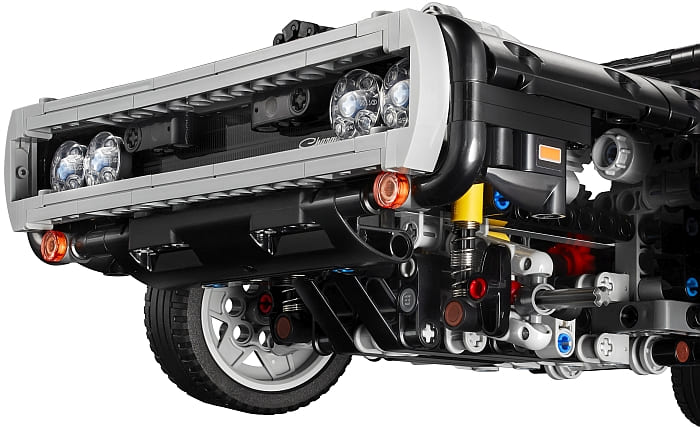
To accomplish this, the back wheels are built into a separate chassis. This is then connected to the main frame of the car by its shocks, a couple of ball links, and a much larger ball cup connection. This large ball cup connection is hollow. So inside it, you will have a linked bush connector to allow two axles to meet, but also turn in the same direction despite being in different positions.
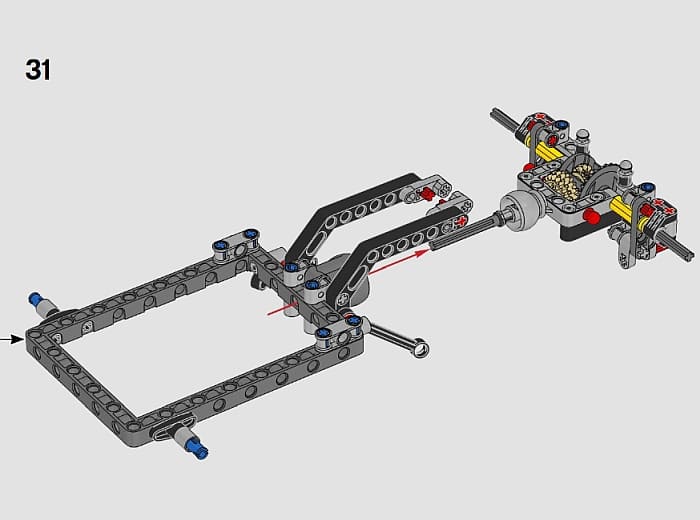
This is actually a great way to approach something that requires flexibility. Consider making the section or part you want to move as a separate piece. Then when you connect it back into the larger structure, that is when you choose the appropriate parts to handle all the motions you want to allow.
APPLYING WHAT YOU LEARN
No matter which building system you use from LEGO, it’s a good idea to understand what each platform provides. Every subcategory of LEGO – LEGO System, LEGO Technic, LEGO Mindstorms, even LEGO DUPLO – does offer something interesting and unique. LEGO Technic just happens to be designed with circles in mind. This is why LEGO Technic has beams with rounded edges. It means they are less likely to catch on edges when turned. This also gives us a reason for why pins are so heavily favored. They are practically hinges in their own right.
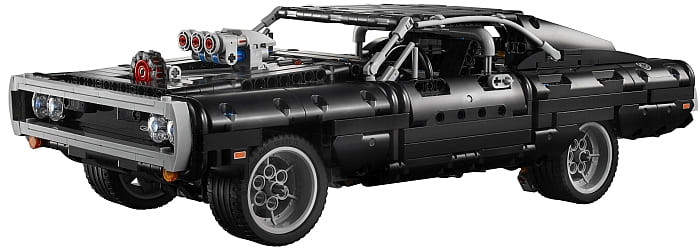
Couple this with LEGO Technic’s ability to flex, and you can make some very interesting functions. Just keep in mind that LEGO Technic is not necessarily stronger than LEGO System. Rather it is more suited to be durable under certain conditions. If you just want to deal with constant weight being pressed down, LEGO System can outperform LEGO Technic quite handily. But if you need your model to move around in a complex fashion, LEGO Technic is your go-to building system for the best stability. Though a great builder will utilize any and all parts for a truly epic creation.
If you haven’t done so already, and if you’re interested, you can pick up the #42111 LEGO Technic Fast & Furious Dom’s Dodge Charger (along with some other awesome LEGO Technic vehicles) at the LEGO Technic section of the Online LEGO Shop.

What do you think? Do you build with LEGO Technic? And what do you think of the building techniques we discussed here? Are there any other interesting techniques in this set you would like to discuss? Feel free to share your thoughts in the comment section below!
And you might also like to check out the following related posts:












This is a good looking vehicle. And the boxy shape fits well with Lego. That section you weren’t sure about is called a differential. It allows the wheels to turn at different speeds.
Here is a fascinating video from 1937 explaining how differentials work: https://youtu.be/yYAw79386WI
Thanks for this. That video explains differentials better than modern education. It’s glorious.
Same thoughts. Love the video!
Thanks so much for the link!
I had a brief conversation with the admin who told me that it was called a differential, but I still wanted to know more. Just forgot to look it up myself.
And as an extra bonus, I now know how to best utilize that odd piece now. 😀
This is why I like technic sets. They are practically a study in mechanical engineering. I just wish they explained in the instructions why and how things worked. I remember I was so confused when the Land Rover’s wheels moved in opposite directions. I had no idea that’s how they supposed to work because of the differential. And I was not the only one. I have seen many people asking on forums what they did wrong.
Something else worth mentioning about this set is that it’s not a racecar or a construction vehicle. It’s unique amongst technic sets, and that’s awesome in itself.
That criterion seems hard to believe…
This is an underrated set. I suppose it’s not as flashy as some of the other ones. But as William said, it has advanced features worth checking out. And it looks awesome from all sides in my opinion.
There’s some clever design in that kit. Nice looking car. I saw a die cast version of the Charger on Amazon.
Could you post full instructions for the steering system or a downloadable instruction manual I lost mine and cant remember how to put it back together
that would be amazing thank you.
Elijah, you can download the building instructions for any LEGO set at the LEGO website: https://www.lego.com/en-us/service/buildinginstructions